Adventures in Anthropocene Reading
Sierra editors review six books with “Anthropocene” in the title

Photo by MaskaRad/iStock
The "Great Acceleration" of the Anthropocene has inevitably led to an accelerating amount of books on the subject. The age of human intervention is now playing out in the world of letters in all genres imaginable, from poetry, art, and critical review to dystopian fiction and even taxidermy. We stacked a pile of books on a table that had "Anthropocene" in the title and grabbed one each at random for a literary adventure down the anthropomorphic rabbit hole.
—Sierra staff
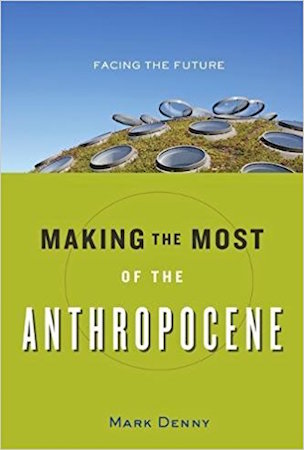 Making the Most of the Anthropocene
Making the Most of the Anthropocene
Facing the Future
By Mark Denny
Johns Hopkins University Press, July 2017
—Jason Mark, editor in chief
At the very beginning of his new book, Making the Most of the Anthropocene, Mark Denny writes, “The importance of the subject has spawned many, many books and articles. Some of these are truly wonderful, well written, and informative, while many others are—not.”
Denny’s own book, I’m sorry to report, falls squarely into that last category.
The title promises a provocative argument for the idea (the hope?) that human civilization just might be able to make the best of the bad situation we’ve constructed for ourselves and other species. While the whole idea of the Anthropocene—naming a geologic epoch after ourselves—might seem distasteful to many people, we should, at the very least, be thinking about how we can navigate this hot and crowded age with the least regrets.
But Denny fails to deliver. It’s not until page 115 that he offers any kind of thesis, and even then he sort bumps into it while walking backward: “I am probably giving nothing away by declaring that, in my humble opinion, technofix is the only sensible answer.”
What do we get in the preceding 100-plus pages? A breezy tour through the economic, social, technological, and biological developments of the last couple millennia which have brought us to the cusp of the Anthropocene. Denny’s whirlwind through history is both facile and tendentious. It includes flabby illuminations like this, “Coal, oil, and gas are collectively known as fossil fuels because they are formed from decayed play and animal matter that has been exposed to geologic processes and turned into combustible matter …” and this, “Solar power is derived directly from the sun, as I hope my readers may have guessed from the name.” Often, the breeziness just comes across as hot air, like this line: “As recently as 20 years ago it made sense to speak of or rant against multinational corporations, but today they don’t exist.” No doubt the executives at Apple and Bayer would be surprised by this claim.
The problem here is that the author appears to have given little thought to the book’s intended audience. The format—42-bite-sized chapters, sometimes, but not always, capped with a couple of wrap-up paragraphs offered in a different font and voice—seems to suggest that Denny imagines this book will be assigned in undergraduate survey courses. But the tone of his frequent addresses to the reader makes it seem like he imagines a politically liberal baby boomer as his interlocutor. Why else assume that, “Doubtless many readers are not quite ready yet for such an argument [in favor of nuclear power]”? It’s not clear for whom the author thinks he’s writing.
Denny apparently believes that cuteness will save him, and at the beginning he promises the book will have plenty of schtick. The schtick falls flat. A presentation of climate science by a consumptive “Professor Albedo” is cringe-inducing. It’s not quite as bad, however, as Denny’s notion that since (liberal) Paul Krugman and (conservative) Niall Ferguson can’t agree on anything, “nobody understands” economics (Denny’s original italics). Maybe Denny thought that his attempts at humor would endear him to a sophomore class readership. But again he’s tripped up by the vagueness of his audience. Sorry, man, but opening your book with a reference to a 1951 film and throwing around lines like “piffle and balderdash” aren’t going to work with the kids these days.
When Denny does reach for big ideas, they slip from his grasp, appearing out of nowhere and then disappearing with the next tiny chapter. Take his treatment of French philosopher Bruno Latour’s idea that we post-moderns must cultivate a romance with our technological creations. You’d be better off reading Latour’s original essay, “Love Your Monsters,” than treading through Denny’s watered-down distillation. (For that matter: If you’re skeptical of eco-modernism and the Anthropocene but willing to keep an open mind, just check out the past couple of years of The Breakthrough Journal, which will serve you better than this book.)
Above all, Making the Most of the Anthropocene is compromised by Denny’s cynicism, which runs like a current throughout the book. “Neither people nor nations are altruistic in general,” he proclaims at one point. A little later he asks, “Am I being too cynical?” Well, yes. Because cynicism is lazy thinking. By accepting the status quo as a natural state of affairs, cynicism lacks both a criticism of the present and an imagining of any different future. In Denny’s treatment, cynicism goes even darker and eventually leads to an epistemological nihilism—since it’s difficult to predict the future, all of our attempts to shape coming events will come to naught. “We have the smarts to think up technofixes … but collectively we are too stupid to put them into effect.”
If that’s the case, then one must wonder: What’s the point of writing a book about how to “make the most” of the new, uncertain age that is upon us?
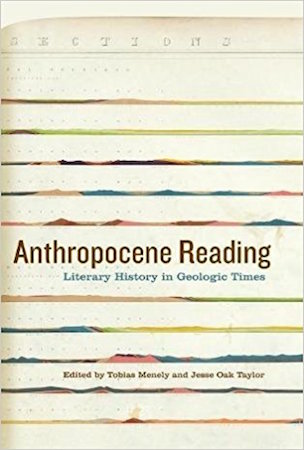 Anthropocene Reading
Anthropocene Reading
Literary History in Geologic Times
Edited by Tobias Menely and Jesse Oak Taylor
Pennsylvania State University Press, October 2017
—Jonathan Hahn, managing editor
There are precious few geographies left in the world that remain untouched by human hands. That story, of the impact our species has had on the earth we call home—the story of the Anthropocene—is written on the very ground on which we stand, the very air we breathe. You can see it in the glaciers that once were and are melting or are now gone; you can taste it in the acrid smoke blanketing California. You can feel it in the water that’s flooding our coastal cities, already polluted by toxins and runoff; you can hear it in the speeches of the political leaders who now run our government—the great ambassadors of the fossil fuels ripping our planet apart.
How exactly do we read the anthropomorphic age unfolding all around us? To what degree can we even read it without flattening that story out into generalities, empty platitudes, simple-minded left/right punditry, or helpless hand-wringing? The answer, of course, stares back at us from the mirror. As we are the authors of the Anthropocene, the only way to better read and understand the story we’ve created must, in some way, involve learning how to read and better understand ourselves.
Tobias Menely and Jesse Oak Taylor have assembled an impressive critical review in Anthropocene Reading: Literary History in Geologic Times. Some 13 contributors wrestle not only with the question of how to read the Anthropocene, but also whether “the Anthropocene might require us to read differently.” “Anthropocene” is not merely the name for an epoch whose central characteristic is how humans shape and are shaped by environmental conditions. It has become an organizing principle for disciplines and social systems in ways never before seen, thus redefining our stories about ourselves. “In the Anthropocene, all scholars are called upon to become Earth system humanists, which involves thinking about how these systems interrelate with, internalize, and destabilize one another.”
Juliana Chow’s wonderful examination of Thoreau’s natural history writings positions his ecology in relation to geologic time (“Thoreau makes crucial distinctions between his protoecological study with its multifaceted timings and the study of strata as a monolithic record of Earth’s history”). Jeffrey Jerome Cohen delivers a biting challenge to the application of the term “Anthropocene” itself and the way it tranquilizes us by squeezing the complexities of this human age into a linear narrative, a “period” we can more easily understand (“The Anthropocene promises to name a problem and thereby ameliorate our anthropogenic nightmares, if only we can let go of the mundane differences that will enable the Anthropocene totality to close and a detached or distant perspective to be achieved”). Thomas H. Ford’s analysis of Jane Eyre, Derek Woods’s critique of The Voyage of the Space Beagle, and discussions of everything from fossil fuels to “fossil poetry” enter into what is essentially a roundtable discussion between scholars grappling with the sheer magnitude of the human era, which figures here not simply as “climate change,” but as an unprecedented “act of writing ourselves into the rock record.”
Don’t look for dispositive analysis out of which the debate on how to read and understand the Anthropocene might be settled. Instead, Anthropocene Reading demonstrates why the era of what some are also calling the "Great Acceleration” reaches into and affects so many fields, sciences, and disciplines. To read the book in its entirety, though, is to get clear on its central message: “In order to expand our horizons, we need to tell different stories, stories that, as [Stephanie] LeMenager suggests, help us form attachments to ‘multiple generations, distant futures as well as distant paths, all times worthy of curation and song.'”
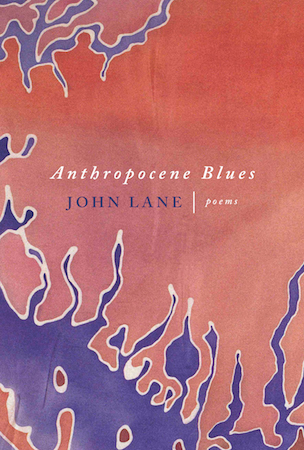 Anthropocene Blues
Anthropocene Blues
Poems
By John Lane
Mercer University Press, September 2017
—Katie O’Reilly, adventure + lifestyle editor
Perhaps poets were busy documenting the earth’s shift from the Pleistocene to the Holocene, but alas, we have no records of their impressions. Now that another epoch is upon us, John Lane is here to herald its dawn. The contemporary poet’s slim, powerful response is chock-full of traveling geologists, pigeons tasked with carrying the heavy load of their genes forward to “reach the next eon,” and laments for dead-on-the-road porcupines and boat hippies (Lane considers the latter a tragically dying breed). There’s no shortage of witty musings in Anthropocene Blues: “Are carbon levels to Geiger counter as stock market is to CNBC?” Lane writes. “Is the latest species’ cha-cha toward oblivion our unrattled success?”
This book’s 30-some poems alternately manifest bitter irony, big-hearted grievance, and earnest inquiry—yet all serve to show how humans believe we’ve become “the planet’s boss, the big chief, the emperor of air, diesel fuel, bow thrusters, and tax shelters.” Several poems bear dark, sumptuous titles (“The Geologist Suspects God Plays Dice” stands out) and contain indulgently satisfying lines (“Death is a spring morning smelling of straw and diesel” and “That poetry is compost is not an original idea”).
Throughout, Lane draws haunting parallels between our newfound cultural and ecological eras. One recurring poem catalogs “web pages left up . . . the messages piled up in Gmail, comments, numbers still live (for dead people) on Skype,” writing, “These will never compost, like discarded beer koozies in a black plastic bag.” While this poet’s musings are at times reminiscent of Jack Handey’s “Deep Thoughts” from 1990s-era SNL, they without fail sharpen into profundity. On the topic of roadkill, for instance, Lane writes, “If we slowed down maybe the whole wild ecosystem would be overrun with porcupines.” He goes on to surmise, “We are nature’s hungriest predator. We are clearing the shoulders for kith and kin.”
I’d recommend Anthropocene Blues for any weary Resistance-ista who needs a break from 2017’s onslaught of digital despair. “Is this age the joke our sapiens ancestors wouldn’t get?” Lane wonders. I suppose we’ll never know, but regardless, I thoroughly enjoyed getting off Twitter long enough to savor this collection’s pointed, ecologically “woke” whimsy.
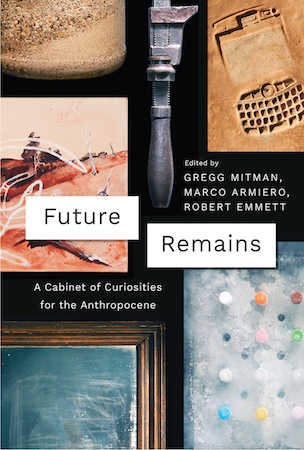 Future Remains
Future Remains
A Cabinet of Curiosities for the Anthropocene
Edited by Gregg Mitman, Marco Armiero, Robert Emmett
University of Chicago Press, March 2018
—Paul Rauber, senior editor
In 16th- and 17th-century Germany, there was a vogue for Wunderkammern or “cabinets of curiosities”—rando collections of books, stuffed crocodiles, weird engravings, dragon teeth, objects real and fictitious that defined the bounds of current knowledge. Future Remains is a self-consciously arty version of the same impulse, a collection of writings (originally brought together in 2014 as a live “Anthropocene slam”) meant to illuminate the ironies, interconnections, and echoes of our new human-dominated epoch. There is a play in the course of which the actors make concrete, “the most used material after water in the world today.” Another chapter meditates on the manual pesticide spray pump, known in the United States as the “Flit gun,” after a brand of insecticide popularized by a young Theodore Geisel, before he became Dr. Seuss. “The pesticide pump straddled the line between toy and weapon,” write Michelle Mart and Cameron Muir, that “illustrates the hubris of a culture convinced it can launch—and win—a war against nature, in this case by chemically manipulating it.”
The saddest curiosity in this collection is an audio relic, a recording made in 1949 of a Māori man named Henare Hāmana (since deceased) whistling the call of a bird called the huia (now extinct) that he knew from his youth. Listening to this echo—across species, across modes of audio recording, writes Julianne Lutz Warren, “might be a new starting place of telling tales, not that everything will be alright, but of widening collaboration of human beings within an ecosphere of mutual belonging, the hope of healing.”
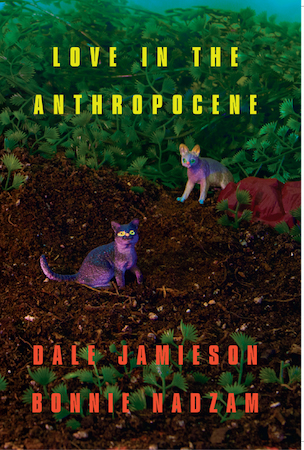 Love in the Anthropocene
Love in the Anthropocene
By Bonnie Nadzam and Dale Jamieson
OR Books, September 2015
—Heather Smith, news editor
I admit, I judged this book by its cover. When I picked it up and started reading it on the train, I assumed I was in for some hyper-pompus, obtuse academic theory. Instead I found a strange amalgam of philosophy and science fiction, a thoughtful—and at times very weird—exploration of what the authors summarize as “love in a world in which nature has become almost entirely an artifact.”
Jamieson is an environmental philosopher and professor at NYU; Nadzam is an accomplished fiction writer. Their collaboration has a cool, uncluttered writing style that reminds me of Golden Age sci-fi writers like Isaac Asimov.
Love in the Anthropocene doesn’t offer up obvious heroes or villains. The characters in the stories often seem strangely OK with the Anthropocene devastation they live in. Nadzam and Jamieson aren’t doing this by accident. “While there are many reasons to be concerned about the future,” they write, “how bad or good it will be will depend to a great extent on the values of those who will live in that world. Consider, for example, present-day New York City. ‘I ❤ NY’ say many of today’s residents and tourists. But the 17th-century inhabitants of Manhattan, the Lenape Indians, would have probably been appalled by much of what present-day New Yorkers and visitors admire: skyscrapers, subways, museums, designer brands, bars and restaurants with a buzz. For all we know, we stand to future people the way that the Lenape stand to us.”
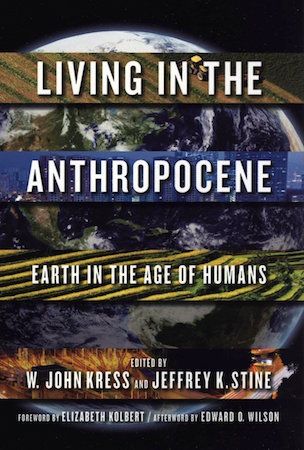 Living in the Anthropocene
Living in the Anthropocene
Earth in the Age of Humans
Edited by John Kress and Jeffrey K. Stine
Smithsonian Books, September 2017
—Wendy Becktold, associate editor
One of the oldest surviving globes, The Hunt-Lenox Globe, which sits in the New York Public Library, is famously inscribed with the Latin words “HC SVNT DRACONES,” or “Here are dragons.” In his essay, “Dragons in the Greenhouse: The Value of Knowledge and the Danger of Uncertainty,” Richard B. Alley uses the metaphor of the incomplete map with the famous inscription to illustrate how when it comes to climate change, what we don’t know is dangerous. Only through knowledge can we equip ourselves with the tools we need to navigate a perilous future. The essay is one of 30 written by a broad cross-section of scientists, historians, archaeologists, and anthropologists, all appearing in the recently published collection, Living in the Anthropocene. Each essayist grapples with where we’ve been (the Holocene and the end we have brought to that era), where we are now (rising sea levels, storms of increasing frequency, dramatic temperature fluctuations, and a timid global response), and where we are going. Though a bit dry and academic in tone, the book is itself a kind of road map for how to think about the new world we are entering, and how to cope with and chase away its many dragons.
 The Magazine of The Sierra Club
The Magazine of The Sierra Club



